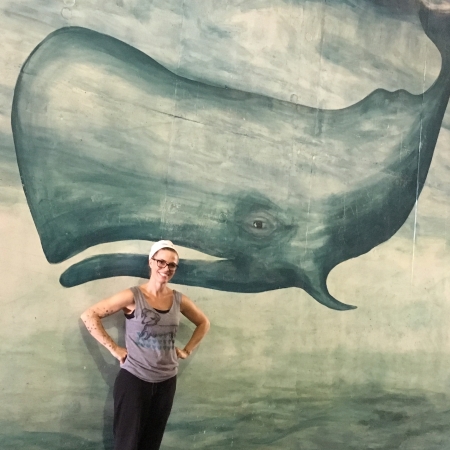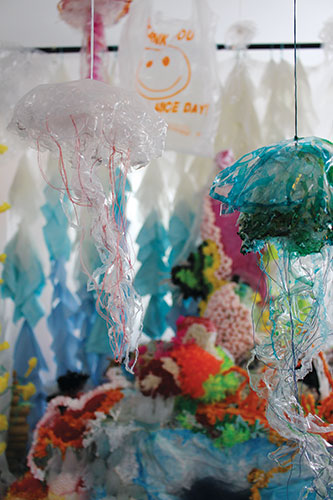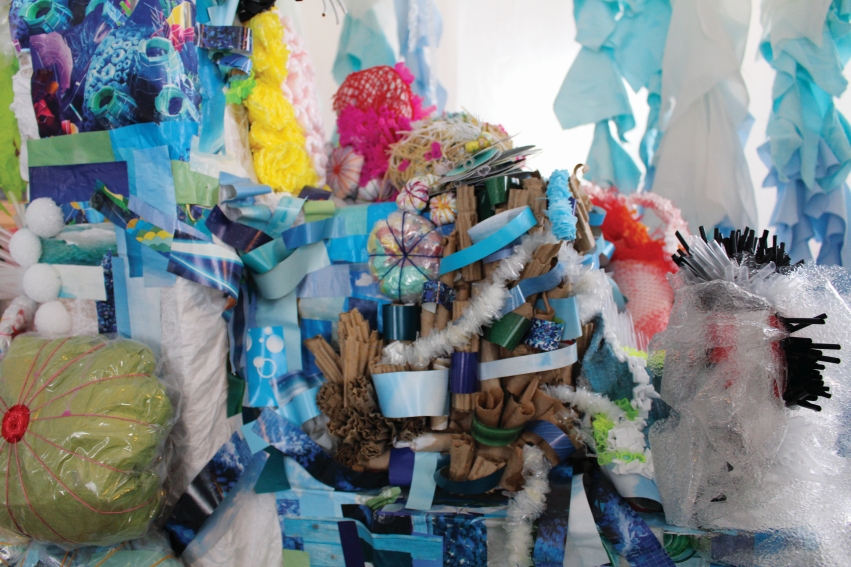A colorful art installation draws local attention to a global crisis.
There’s a ton of straws. There’s tulle… which is like a fabric netting. Bread bags and vegetable bags. Plastic-coated wire. A window cling. To-go cups. Styrofoam bowls, Styrofoam cups, Styrofoam peanuts. Plastic silverware. Plastic wrap.”
Those are just a few of the elements that comprise Jessica McGhee’s latest art project. “I call it a reef, but it’s really an aquatic environment. It kind of mimics the idea of a coral reef.”
A lifelong artist in various mediums, McGhee got her creative start after winning a drawing contest in the fourth grade. She once helped transform a downtown Peoria bar into New Orleans for a Mardi Gras party, then was asked by the owner to paint something that looks like a Picasso. “No challenge there!” she laughs. “I ended up doing a whole series and had a show at One World [Café]—one of their first art shows.”
McGhee painted the first of many murals to come in the One World bathroom in 2001, about the time she started making jewelry under the name Hey Lola. More than a decade later, she and her husband were running Blue, a bar on West Main Street, when her life hit a rough patch. “I had a nervous breakdown,” she admits. “And I started painting my feelings on the walls at Blue.” She didn’t know it then, but this turned out to be “one of the best things that ever happened to me.”
 Soon she was painting the exterior of Fifth Avenue Fashions three blocks away, which led to a commission inside of Las Delicias, the ice cream shop next door. Most recently, she helped convert the newly-opened Lava Tiki Lounge into a tropical paradise with a mosaic bar top and floor-to-ceiling murals throughout. But it was her work last year on another downtown mural which led to a momentous shift in her life.
Soon she was painting the exterior of Fifth Avenue Fashions three blocks away, which led to a commission inside of Las Delicias, the ice cream shop next door. Most recently, she helped convert the newly-opened Lava Tiki Lounge into a tropical paradise with a mosaic bar top and floor-to-ceiling murals throughout. But it was her work last year on another downtown mural which led to a momentous shift in her life.
“It’s probably the biggest mural in Peoria, but it’s very well-hidden,” McGhee notes. Near the Adams street entrance of the Niagara Parking Deck, she brought a neglected concrete wall to life—a colorful tapestry of flowers and wildlife leading into an oceanic extravaganza, complete with two giant whales, a large octopus, a coral reef, a sea turtle and other aquatic characters.
The theme was a poignant one for McGhee, whose recovery was aided by long walks along the shore of the Emiquon Preserve near Havana. “Water makes me feel better—it’s very healing. It really came out when I was not feeling my best.”
On the bright side, the tough times were fuel for her art. “It changed my life,” she explains. “It sent me to Costa Rica. It was really horrible, and then everything became the way it’s supposed to be.”
Conservation Vacation
With its rainforest climate and dual coastlines full of marine life, the biodiversity of Costa Rica is practically unparalleled. Last November, inspired by her mural in Peoria, McGhee spent three pivotal weeks there—but this was no ordinary vacation.
“I had painted this huge ocean scene, and it struck me that I’d never seen a sea turtle in real life,” she recalls. “And it had been a really long time since I saw the ocean. So I stayed up late one night… googling conservation trips.” She ended up on the beach at Ostional, a small village on the Pacific side of the country. The federally protected wildlife refuge encompasses two biological research stations, one of which hosted McGhee as a volunteer—and is well known for its annual sea turtle migration.
 Olive ridleys, the most abundant of the world’s sea turtles, nest at Ostional by the hundreds of thousands. “While I was there, we experienced what’s called arribada, which means ‘the arrival,’” she explains. “When you’re in the middle of arribada on the beach, you can hardly walk—there are so many turtles.”
Olive ridleys, the most abundant of the world’s sea turtles, nest at Ostional by the hundreds of thousands. “While I was there, we experienced what’s called arribada, which means ‘the arrival,’” she explains. “When you’re in the middle of arribada on the beach, you can hardly walk—there are so many turtles.”
Her volunteer duties included tagging the olive ridleys, counting their eggs and recording other data, while looking out for endangered leatherbacks and green sea turtles, which are far less common. (Their eggs, when found, are collected and taken to a nearby hatchery—away from the vultures, dogs and poachers that threaten them—which dramatically improves their chances of hatching.)
Taking part in numerous beach cleanups, she was overwhelmed by the sheer volume of plastic waste interspersed amongst the shells and driftwood, which creates an obstacle course for newly-hatched sea turtles attempting to reach the ocean. The unnervingly colorful wrack line—the line of debris left ona beach at high tide—drew the artist in. Picking up a discarded water bottle, McGhee began filling it with tiny plastics. “I thought I might make jewelry out of it,” she explains.
One night she and her team were fortunate to encounter a leatherback on the beach. “It was incredible—they’re huge!” she exclaims. “We really bonded over the experience.” Adult leatherbacks, the largest of all living turtles, subsist almost entirely on jellyfish. “And plastic bags really look like jellyfish in the ocean,” she notes. “So they eat them. And it kills them.”
McGhee’s trip to Costa Rica had placed her right in the thick of the global plastic problem. “Working with creatures directly affected by it, and knowing this is a species that could be extinct in our lifetime because of something we do…” she trails off. “I wanted to make sure I took the experience back with me.”
Playa de Plástico
Returning to Illinois with that water bottle and two Ziploc gallon bags full of plastics, McGhee was determined to reduce her household’s reliance on the ubiquitous synthetic. “We made the decision not to throw anything away,” she explains. “Everything is either composted, recycled or saved. So I have tubs full of plastic.”
Before long, an art project developed. It started with a simple “jellyfish” made out of a plastic bag—“because of the sea turtle connection. And then the ‘reef’ somehow just happened.”
Any plastics that couldn’t be reused or recycled were incorporated into the reef, which she dubbed Playa de Plástico. Using an old tabletop she found at a thrift store for its base, McGhee dressed it up with some plastic tablecloths. “None of the plastic was purchased,” she stresses. “It’s all garbage that I either brought back from Costa Rica, already had in my possession, or literally picked up off the streets of Peoria.”
As the project grew in size and scope, she began posting pictures on social media, updating her circle of friends in real time and drawing attention to the issue of plastic waste disposal. “We’re a society that’s really reliant on plastics,” McGhee notes. “In many cases, they make life better, safer and healthier. But our use of them is really irresponsible.”
Changing her own shopping habits was not easy, she admits. “The first time I tried to go grocery shopping plasticfree, I couldn’t do it.” It required a lot of research, going to multiple stores, sometimes spending a little more, and adapting to the inconveniences. “It’s a lifestyle change. We had to valuate where to make the tradeoffs.”
Playa de Plástico, still a work in progress, has become a traveling exhibit, giving McGhee a vibrant platform from which to engage the public in discussion—though “it’s not the easiest thing in the world to set up,” she adds with a smile. She has already displayed it at her church and at the Sun Foundation’s Clean Water Celebration, while fielding requests to take it into local schools. She’s excited to share the colorful creation, and more importantly, the message behind it.

A Movement Builds
The worldwide problem of plastic waste can feel so deeply entrenched that it overwhelms people’s good intentions and leads to inaction. McGhee herself needed a place to start. “So my big thing is single-use plastics: your Ziploc bags, your grocery bags, plastic silverware, straws, to-go cups, K-cups,” she says, adding that no one can save the world on their own. “You just have to evaluate where you can make little changes. And once you get those done, make some more.”
By simply forgoing a straw when dining out, for example, one can start to make an impact. “There are nearly 600 restaurants in the Peoria area,” McGhee notes. “Let’s assume they all use 12 straws an hour and they’re open 10 hours a day, seven days a week. Then take that number and cut it in half… You’re still looking at more than 30,000 straws a day— just in the Peoria area.”
The message has begun to reach critical mass. The Sun Foundation has been promoting the issue locally, and April 23, 2018, was proclaimed “Skip the Straw Day” in the City of Peoria. Several area restaurants have begun passing out straws on request only, while some have transitioned their to-go boxes away from plastic.
Even McGhee’s reef creation is riding a wave of similar projects around the country. An exhibit of aquatic animal sculptures, created entirely from ocean garbage, recently made its way to the Shedd Aquarium. Closer to home, the Peoria PlayHouse Children’s Museum is partnering with a class at Bradley University to create an underwater art exhibit out of recycled plastics. Governments around the world, including the U.K. and China, are starting to get serious about the problem of plastic waste—cracking down on single-use plastic bags, among other gestures.
“It’s kind of a movement,” McGhee affirms. But even as she helps spread the word, she’s cautious not to appear judgmental. “Plastic is everywhere. Breaking our reliance on it, 100 percent right off the bat, is not realistic. Then you will get overwhelmed and you won’t do anything.
“You have to weigh the things that are important to you with what’s economically feasible, and that is hard,” she says. “Plastic has definitely pushed our society forward. Now we have to figure out where that happy medium is.” a&s


